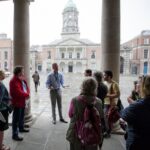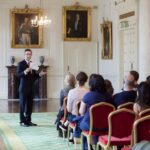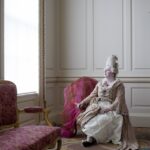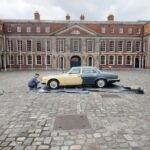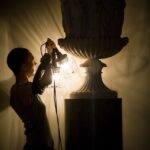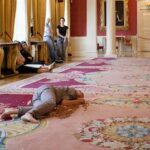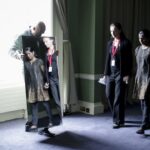These Immovable Walls: Performing Power at Dublin Castle
Article published in Italian on “Exibart” (29 September 2014) and here translated in English.
The deep symbolic meaning of Dublin Castle lies in its representation of the history of the city itself and all of Ireland. The name of the capital is derived from the site of the building, Dubh Linn; it has been a fortress, prison, court palace, residence of the viceroy of England and therefore, for more than 700 years, a symbol of British occupation. Since 1922, since the proclamation of the Irish Free State, it has belonged to the Irish government and carries out a ceremonial function.
On the tourist map of the city, the Castle is one of the places to be seen, which means it is traversed continuously by streams of visitors, who take a quick look and compulsively snap their photos.
What would happen if, during a standard visit through its spaces, one stumbled upon performance acts that seemed to violate the sanctity given to some of the objects on display, or that called into question the inherent symbolism of a place as representative of power as this one is?
That’s exactly what happened last July 11th and 12th, thanks to the initiative These Immovable Walls, curated by Michelle Browne and with the collaboration of Ciara MacKeon, during which seven performances by Irish and international artists explored the idea of power in its various forms, throwing the ordinariness of sightseeing into turmoil, sparking behavioural short circuits not only in the visitors, but in the Castle’s own staff, and probably also in the artists, too used to performing only in places dedicated to contemporary art.
This was certainly the aspect that most interested Maurice O’Connell, who went through all the rooms of the castle, with his Audi Vide Trace, during those two days. Partly as a visitor, partly as a staff member – legitimized by his badge –, he dialogued in various ways with the audience and the interiors of the Castle.
The work of Kateřina Šedá, entitled First Class, was based on the liberating possibilities inherent to being justified in doing something unusual or prohibited, like being able to fulfil a wish. From a list of 15 possibilities, you could choose to put your own portrait in the Portrait Gallery, or park a bicycle in the courtyard, run throughout the Castle, or to sing in the State Apartments.
Of a more theatrical flavour, instead, were Still Life by Carey Young and The Spy at the Gate by Pauline Cummins, both performances with limited spaces.
Still Life was the reading of a will, acted out by Mark Oosterveen and addressed to the audience itself. The audience becomes depositary of four items whose colour and shape are described again and again, to emphasize the importance of the mnemonic act, to preserve the same value and memory of those objects that the owner had.
The 22 visitors at the Pauline Cummins performance were the children of Emily, the Duchess of Leinster. Each one bore his or her name and spirit with a white balloon, while the Duchess narrated her story and then served tea in the Drawing Room. The performance concluded with a march outside the castle, to St Werburgh’s Church, where one of Emily’s sons, Lord Edward FitzGerald, is buried. He appeared in the church to tell of his revolutionary life and tragic death.
continue after images…
The works of Philip Napier, Sandra Johnston and Dominic Thorpe were instead aimed at more recent political history.
The first, with Soon – nickname of Margaret Thatcher’s spokesperson during the Anglo-Irish negotiations -, made his work more visible, since he is interested in the media-related aspects of power. In the Castle’s courtyard, there was a granite pillar engraved with the word that gives the work its title. On the first day, a grey Jaguar was painted the same shade of yellow as the walls of the Queen’s Room, the room where Thatcher slept (during one of her three stays at the Castle). On the second day, instead, the Jaguar was occasionally driven around in a circle – that absurd and endless circle of the Iron Lady.
Entitlement by Sandra Johnston was a work in two acts. The first took place on the first day in the State Corridor. Five long cables feeding five torches crossed the corridor in the dark. The artist walked slowly, aided first by the light of only one torch and then, progressively adding the others, one by one. The addition of each light source also increased the weight and the artist’s fatigue, forcing her to wrap the long cables around her own body (first on her arms, then around her chest and neck). A slow, silent and laborious journey through history, in search of nearly invisible traces, accumulated over time. As the curator claims, this work is reminiscent of the tiring, dark work of miners, while the hundreds of one-cent coins Johnston used on the second day in the Drawing Room symbolically referred to the masses, the people. The artist first tried to hold them all in her lap but they then fell, following her movements, slowly, and shone on the coloured and precious carpet, where Johnston, lying down, tried to literally drag them all with her in an uneven battle between the multitude and the individual, or in an immense and extreme gesture of maternal compassion, the opposite of the significance given to the statue of Justice when it was erected in the Castle’s courtyard. In fact, the statue has its sword pointing upwards (instead of down) and its back to the city.
Dominic Thorpe, for his Proximity Mouth, chose the building that faces the courtyard on the side opposite to the entrance of the State Apartments, which held, from the 1940s to the 80s, the Children’s Court where many children were brought to trial and sent to industrial schools run by the Catholic Church. This is a recent history (which is still spoken little about) that the artist brings to our attention with a very strong performance in which we are led into the main hall of the court, hand in hand with a recent or current asylum seeker in Ireland. We find ourselves face to face with an uncomfortable reality – our own faces reflected in the mirror that Thorpe spins and where his open mouth remains silent, hitting against the mirror. Upon leaving, we take away a paper, meticulously folded by an adolescent into the shape of a boat or plane (depending how the viewer feels), with a printed list of the Irish provision centres for asylum seekers.
The subtle input into behavioural interstices, the denunciation of history, the burden of shedding light on memory, the media spectacle of politics… all overlap with the daily routine of the Castle on dates of some importance to the history of Ireland, and particularly of the North. It was a coincidence and yet it’s impossible not to note: on July 12th, The Twelfth, the Protestants celebrate their supremacy in Northern Ireland with parades organized by the order of Orange. The celebration is preceded, the night of July 11th, by the lighting of bonfires built in the previous months, with a violently anti-Catholic flavour.
The day after These Immovable Walls, the courtyard of the Castle where Philip Napier’s yellow Jaguar circled aimlessly, was literally covered with diplomatic cars for the ceremonial lunch of July 13th, the National Day of Commemoration of all Irish people who died in past wars.
Suddenly, a foreigner in Ireland understands the strategic importance of this place and comes to appreciate the courage of an initiative like this even more, where contemporary art is really able to shed light on various aspects of power.
Manuela Pacella
